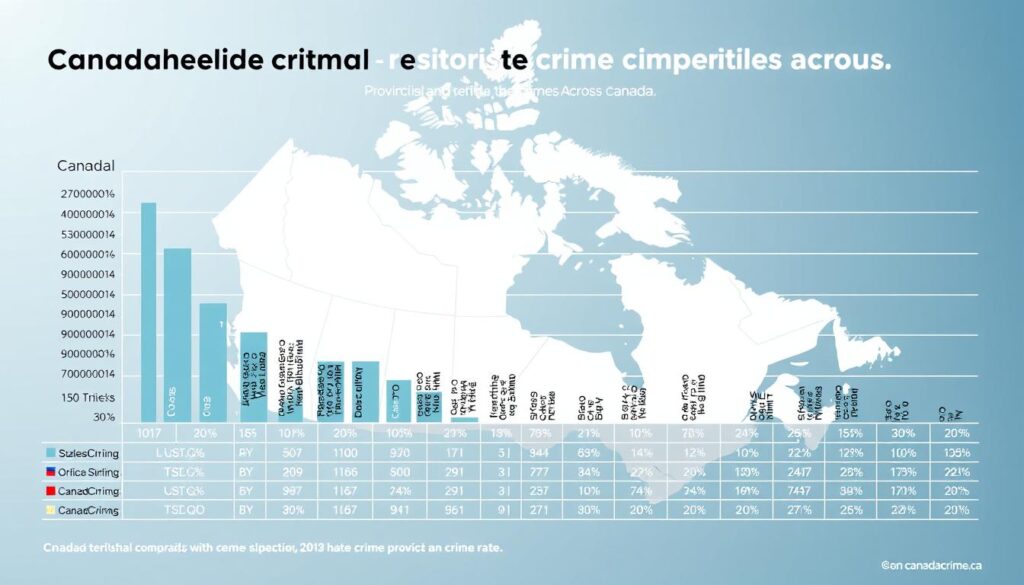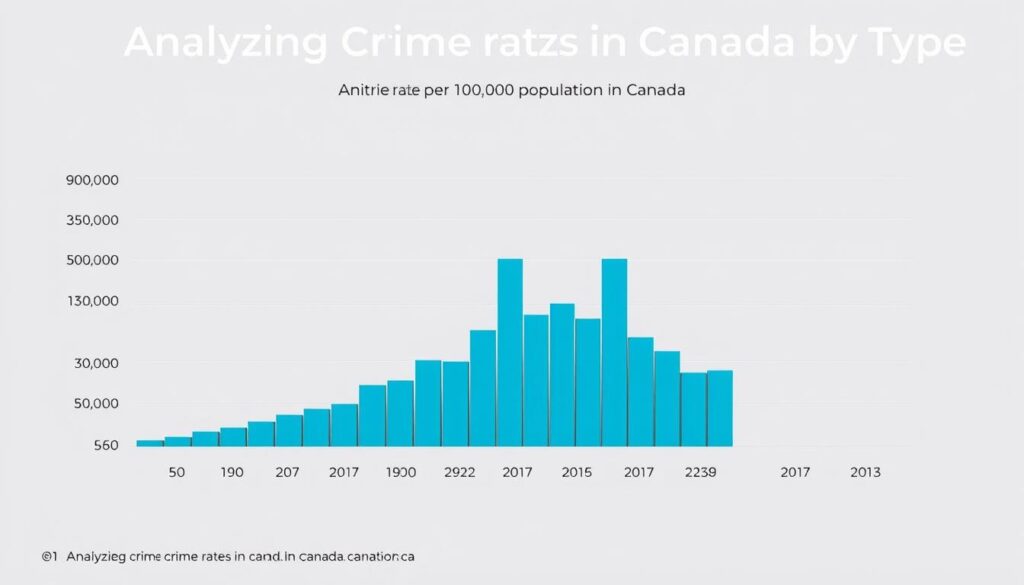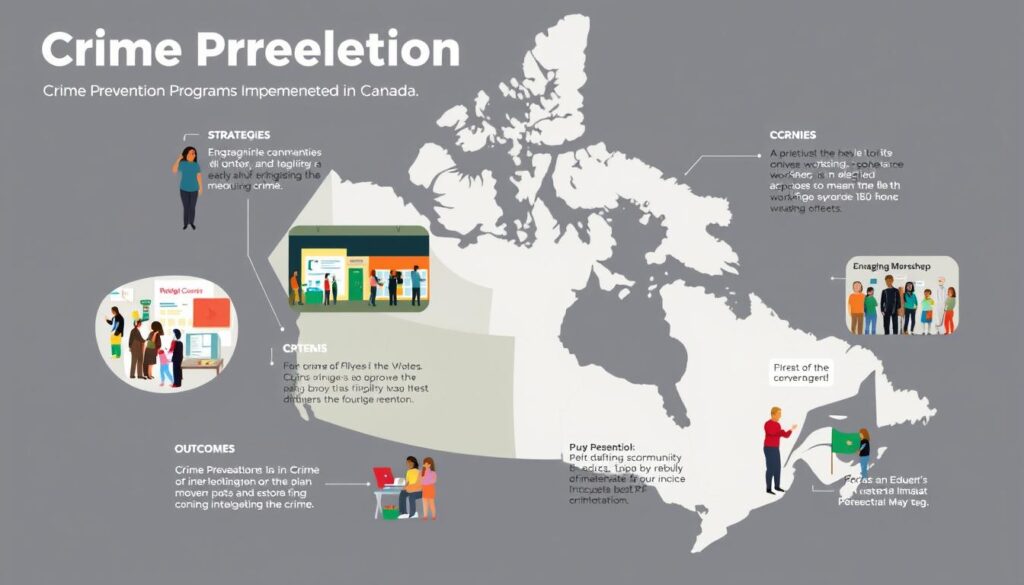Canada’s crime landscape has seen significant shifts over the past few decades. According to Statistics Canada, the overall crime rate had been declining steadily since the late 1990s, as measured by the Crime Severity Index (CSI) and the Violent Crime Severity Index (VCSI).
However, recent data indicates a reversal of this trend, with the CSI rising by 2% in 2023, marking the third consecutive year of increase. This change is part of a broader trend that began in 2015, following an all-time low in 2014. Between 2010 and 2018, both measures of crime severity saw an 8% to 10% decrease.
This comprehensive guide will explore the current landscape of crime statistics across Canada, providing detailed insights into the Canadian Criminal Code and regional differences in crime patterns.
Current Crime Rates in Canada: A National Overview
The crime rate in Canada is a multifaceted issue, with both violent and non-violent crimes contributing to the overall picture. To understand the current state of crime in Canada, it’s essential to examine the national statistics and trends.

The Crime Severity Index Explained
The Crime Severity Index (CSI) is a statistical measure that reflects the relative seriousness of crime in Canada. It takes into account the volume and severity of crimes reported to the police. The CSI is a valuable tool for understanding the crime landscape, as it provides a more nuanced view than simply looking at the number of crimes. For instance, a decrease in the CSI indicates a reduction in the severity and/or volume of crimes.
Key aspects of the CSI include:
- Weighting crimes based on their seriousness
- Incorporating both violent and non-violent offenses
- Providing a comprehensive view of crime trends
Recent Trends in Canadian Crime Statistics
Recent data indicates that while the Violent Crime Severity Index (VCSI) remained relatively stable in 2023, there were significant decreases in homicide rates, which fell by 14% compared to the previous year. In 2023, there were 778 victims of homicide, 104 fewer than in 2022. Gang-related homicides continued to account for about one-quarter (22%) of all homicides, with 78% of these being committed with a firearm, most often a handgun.
For more detailed information on crime rates in Canada, you can visit this resource that provides comprehensive insights into the topic.
| Crime Type | 2022 | 2023 | Change |
|---|---|---|---|
| Homicides | 882 | 778 | -14% |
| Gang-related Homicides | 22% | 22% | 0% |
| Violent Crime Rate (per 100,000) | 1,051.62 | 1,051.62 | 0% |
Comparing Violent and Non-Violent Crime Rates
The distinction between violent and non-violent crime provides crucial context for understanding Canada’s overall crime landscape. Violent crime in Canada, as measured by the VCSI, remained relatively stable in 2023. However, non-violent crimes, particularly property and fraud-related offenses, drove the overall increase in the Crime Severity Index. The rate of violent crime per 100,000 population stands at approximately 1,051.62 across Canada, though this figure varies significantly by province and territory.
The varied crime rates across different regions highlight the need for targeted crime prevention strategies.
Understanding the Canadian Criminal Code

Understanding the intricacies of the Canadian Criminal Code is essential for grasping how crime is defined and prosecuted in Canada. The Code is a comprehensive legal framework that categorizes various criminal offenses and guides legal proceedings.
Structure and Organization of the Criminal Code
The Canadian Criminal Code is structured to classify offenses into distinct categories, primarily between indictable offenses (more serious crimes) and summary offenses (less serious), with some hybrid offenses that can be prosecuted either way. This classification is fundamental to understanding how crimes are reported and tracked.
The Code is organized in a manner that facilitates the prosecution of criminal offenses, providing a clear framework for legal proceedings. It addresses a wide range of crimes, from violent offenses like homicide and assault to property crimes such as theft and mischief.
Key Criminal Offenses and Their Classifications
Violent criminal code violations include a range of serious offenses such as homicide (2.25 per 100,000), attempted murder (2.16), sexual assault (90), assault (503), robbery (56), and uttering threats (224), totaling 1,365 violations per 100,000 population in 2022. Property crime violations, on the other hand, are more prevalent, with theft under $5,000 being the most common (963 per 100,000), followed by mischief (807) and breaking and entering (341), totaling 3,314 per 100,000 population.
The Criminal Code also addresses emerging areas such as cybercrime, hate crimes, and terrorism, with recent amendments strengthening provisions related to online offenses. Understanding these classifications is crucial for contextualizing crime statistics and comparing crime rates across different regions and time periods.
Provincial and Territorial Crime Rate Comparison
Regional crime rates in Canada vary substantially, influenced by a complex interplay of demographic, economic, and environmental factors. Understanding these variations is crucial for developing effective crime prevention strategies tailored to the specific needs of different regions.
Highest Crime Rate Provinces and Territories
The western provinces and territories generally experience higher crime rates compared to their eastern counterparts. Manitoba and Saskatchewan are notable for having the highest violent crime rates among the provinces. These regions face unique challenges, including geographic isolation and limited economic opportunities, which can exacerbate crime rates.
For more detailed information on Canada’s crime rates and the factors influencing them, visit Canada’s Crime Rates.
| Province/Territory | Crime Severity Index | Violent Crime Rate |
|---|---|---|
| Manitoba | 134.46 | Highest |
| Saskatchewan | 128.41 | Second Highest |
| Nunavut | 354.67 | Significantly Higher |
Lowest Crime Rate Provinces
In contrast, the eastern provinces tend to have lower crime rates. Newfoundland and Labrador, Prince Edward Island, and Quebec are among the provinces with the lowest crime rates. These regions often benefit from stronger community cohesion and better access to social services, contributing to their lower crime rates.

Factors Influencing Regional Crime Differences
Several factors contribute to the disparities in crime rates across Canada’s provinces and territories. Socioeconomic factors, such as poverty and unemployment, play a significant role. Additionally, population density and urbanization influence crime patterns, with urban centers generally experiencing higher crime rates than rural areas. The availability of social services, including mental health support and addiction treatment, also impacts crime prevention effectiveness.
“The relationship between socioeconomic factors and crime rates is complex, and addressing these underlying issues is crucial for reducing crime.” –
Historical and ongoing issues affecting Indigenous communities, particularly in the territories and prairie provinces, also contribute to higher crime rates in these regions. Understanding and addressing these complex factors is essential for developing effective crime prevention strategies.
Top 10 Most Dangerous Cities in Canada

Canadian cities exhibit a range of crime rates, with some being considered more dangerous than others. The crime rate in urban areas is influenced by various factors, including socioeconomic conditions, policing strategies, and community engagement.
Crime Severity Index Rankings by City
The Crime Severity Index (CSI) is a statistical measure that takes into account the volume and severity of crime in a given area. According to recent data, Winnipeg saw a significant jump in crime severity, with a 20% increase between 2021 and 2022, making it one of the cities with the highest crime rates in Canada.
Saskatoon also reported troubling trends, with a 65.6% increase in interactions between fire crews and inadequately housed individuals between 2022 and 2023. The Saskatoon Police Service reported a record 150,000 calls for service in 2024, marking a 12% increase from 2023.
Common Crime Types in High-Risk Urban Areas
High-risk urban areas in Canada experience a range of crime types, including violent crime and non-violent crime. Technology-facilitated crimes, such as fraud and identity theft, have also seen a significant rise in these areas. The adaptability of criminals to digital platforms has led to an increase in sophisticated scams targeting urban populations.
Recent Changes in Urban Crime Patterns
Urban crime patterns have shown significant shifts in recent years. The COVID-19 pandemic temporarily disrupted crime trends, with initial decreases in certain property crimes during lockdowns followed by subsequent increases as restrictions lifted. In Red Deer, property crimes have significantly decreased according to recent RCMP reports, while person-on-person crimes have shown a slight increase, demonstrating that not all high-crime cities follow the same patterns.
Safest Places to Live in Canada

For those looking to relocate or simply seeking a secure environment, Canada boasts several cities with exceptionally low crime rates. These cities offer not only safety but also a high quality of life, making them attractive to residents and visitors alike.
Cities with the Lowest Crime Rates
Some of the safest cities in Canada are characterized by their low crime rates per 100,000 residents. These cities benefit from various factors, including strong economic conditions, robust social services, and demographic factors that correlate with lower crime incidence. For instance, Prince Edward Island is known for its rural communities with strong social cohesion, which often experience lower crime rates, particularly for violent offenses.
What Makes These Areas Safer?
Several factors contribute to the lower crime rates in these areas. Economic prosperity plays a crucial role, with safer regions typically featuring lower unemployment rates, higher median incomes, and more stable housing markets. Additionally, community engagement and social cohesion serve as powerful crime deterrents, with safer cities often having active neighborhood watch programs and community policing initiatives.
Other significant factors include strategic urban planning, which contributes to safety through well-designed public spaces and adequate lighting, and educational attainment, which correlates strongly with lower crime rates. Effective municipal governance and adequate funding for social services also create environments where preventative approaches to crime can thrive.
Analyzing Crime Rates in Canada by Type
Analyzing crime rates by type provides valuable insights into the nature of criminal activity across Canada. The country’s crime landscape is diverse, with different types of crimes affecting various regions in distinct ways. Understanding these differences is crucial for developing effective crime prevention strategies.
Violent Crime Statistics
Violent crimes, including sexual assault, robbery, and homicide, contribute significantly to Canada’s overall crime rate. According to recent statistics, the rate of violent crime has seen fluctuations, with some areas experiencing higher rates than others. The national average for violent crime stands at 760.41 incidents per 100,000 population, though this figure varies dramatically across different provinces and territories.
Regions with higher concentrations of violent crime often correlate with socioeconomic factors such as poverty and lack of access to education and employment opportunities. Addressing these underlying issues is key to reducing the crime rate in these areas.
Property Crime Trends
Property crimes, including theft and property damage, are among the most common types of crime in Canada. Recent trends indicate that while overall crime rates have seen some fluctuations, property crime remains a persistent issue. The national rate for property crimes is significantly higher than that of violent crimes, with an average of 2,134.81 incidents per 100,000 population.
Factors such as urbanization and economic conditions play a significant role in property crime trends. Areas with higher costs of living and greater economic inequality tend to experience higher rates of property crime.

Drug-Related Offenses
Drug-related offenses represent a significant portion of Canada’s criminal landscape, with a national rate of 262.96 violations per 100,000 population. The opioid crisis has had a profound impact on crime statistics, with drug-related offenses often correlating with increases in property crimes as individuals with substance use disorders may resort to theft to support their addiction.
British Columbia reports the highest provincial rate of drug violations at 452.63 per 100,000 population, nearly double the national average. The territories also report exceptionally high rates of drug violations, highlighting the severe substance abuse challenges facing northern communities.
Law Enforcement in Canada

The effectiveness of law enforcement in Canada is influenced by the distribution and density of police forces across the country. As of 2005, Canada had 61,050 police officers, which translates to one police officer per 528.6 persons.
Police Forces Across Canada
Canada’s police forces are distributed unevenly, reflecting regional variations in population density and crime rates. Urban centers like Toronto, Montreal, and Vancouver have higher concentrations of police officers compared to rural areas.
Regional Variations: The northern territories have the highest police-to-population ratios, with Nunavut having one officer per 247.9 persons, followed by the Northwest Territories and Yukon.
Police-to-Population Ratios by Region
The police-to-population ratio varies significantly across Canada. While the national average is one police officer per 528.6 persons, provinces like Newfoundland and Labrador and Prince Edward Island have fewer police officers per capita, with ratios of 664.9 and 648.4 persons per officer, respectively.
- Canada maintains a relatively low police-to-population ratio compared to other developed nations.
- Significant regional variations exist, with the territories having the highest concentration of officers.
- Atlantic provinces generally have the lowest police presence.
Understanding these variations is crucial for assessing the effectiveness of law enforcement and allocating resources appropriately.
International Comparisons: How Canada Stacks Up
Canada’s safety record is noteworthy when viewed through a global lens. The country’s crime rates are often compared to those of other developed nations to gauge its relative safety.
Canada vs. United States Crime Rates
One significant comparison is between Canada and the United States. Canada’s homicide rate is approximately 2.7 times lower than that of the U.S., making it one of the safer countries in the Americas. This disparity is attributed to various factors, including stricter gun control laws and lower levels of social inequality in Canada.
| Country | Homicide Rate per 100,000 |
|---|---|
| Canada | 1.95 |
| United States | 5.35 |
Global Peace Index Rankings
According to the Institute for Economics & Peace Global Peace Index, Canada is ranked the 11th safest country out of 163 nations. This ranking reflects Canada’s low levels of violent crime, political stability, and minimal involvement in international conflicts.
The Global Peace Index highlights that Canada shares the top position in the Americas with Chile. Canada outperforms several developed nations in safety metrics, including Australia, England, France, and Ireland. Factors contributing to Canada’s strong safety record include effective governance, social welfare systems, and relatively low income inequality.

Preventing Crime in Canadian Communities

Preventing crime in Canada requires a comprehensive strategy that encompasses community engagement and government initiatives. Effective crime prevention involves addressing the root causes of criminal behavior and implementing evidence-based programs.
Community-Based Prevention Initiatives
Community-based initiatives play a crucial role in preventing crime. Public Safety Canada’s National Crime Prevention Strategy (NCPS) funds initiatives targeting at-risk populations and high-crime communities. The Youth Criminal Justice Act emphasizes rehabilitation and reintegration for young offenders, focusing on diversion programs and community-based sentencing.
Crime prevention through environmental design (CPTED) principles is also being incorporated into urban planning, using design strategies to naturally deter criminal activity.
Government Crime Prevention Strategies
The Canadian government collaborates with provincial and municipal authorities to address the social determinants of crime. Initiatives include poverty reduction strategies, affordable housing programs, and mental health services. The Department of Justice Canada funds research and evaluation of crime prevention programs, ensuring that resources are directed toward effective interventions.
By working together, government agencies and community organizations can create safer environments and reduce crime rates across Canada.
Conclusion: The Future of Crime Rates in Canada
As Canada continues to navigate the complexities of crime trends, understanding the future outlook becomes increasingly important. The Crime Severity Index (CSI) rose by 2% in 2023, marking the third consecutive year of increase and continuing a trend that began in 2015. This rise, combined with a 43.8% increase in violent crime rates between 2014 and 2022, presents a complex picture for the future.
Several factors will influence the trajectory of crime rates in Canada. Digital crime, including cybercrime and online fraud, is emerging as a significant challenge, growing at rates that outpace traditional crimes. The dramatic increase in violent crime rates signals a troubling reversal of Canada’s long-term crime reduction trends, necessitating a renewed focus on violence prevention strategies. For more detailed information on crime trends and statistics, refer to the report by Public Safety Canada.
Youth crime prevention remains critical for long-term crime reduction. Effective early intervention programs can significantly reduce future criminal behavior and incarceration rates among youth. Additionally, Canada’s approach to crime prevention will likely require an increasing integration of social services, mental health support, addiction treatment, and law enforcement to address the complex factors driving criminal behavior.
Demographic shifts, including Canada’s aging population and increasing urbanization, will continue to influence crime patterns. The ongoing opioid crisis and climate change may also impact future crime rates, requiring coordinated responses from health, justice, and emergency response systems. Technological advances in law enforcement offer new tools for crime prevention but also raise questions about privacy and civil liberties.
Despite recent increases in crime rates, Canada’s international reputation for safety remains strong. Maintaining this standing will require proactive approaches to emerging crime trends and continued investment in evidence-based prevention strategies. By understanding these complex factors and trends, Canada can work towards a safer future.

